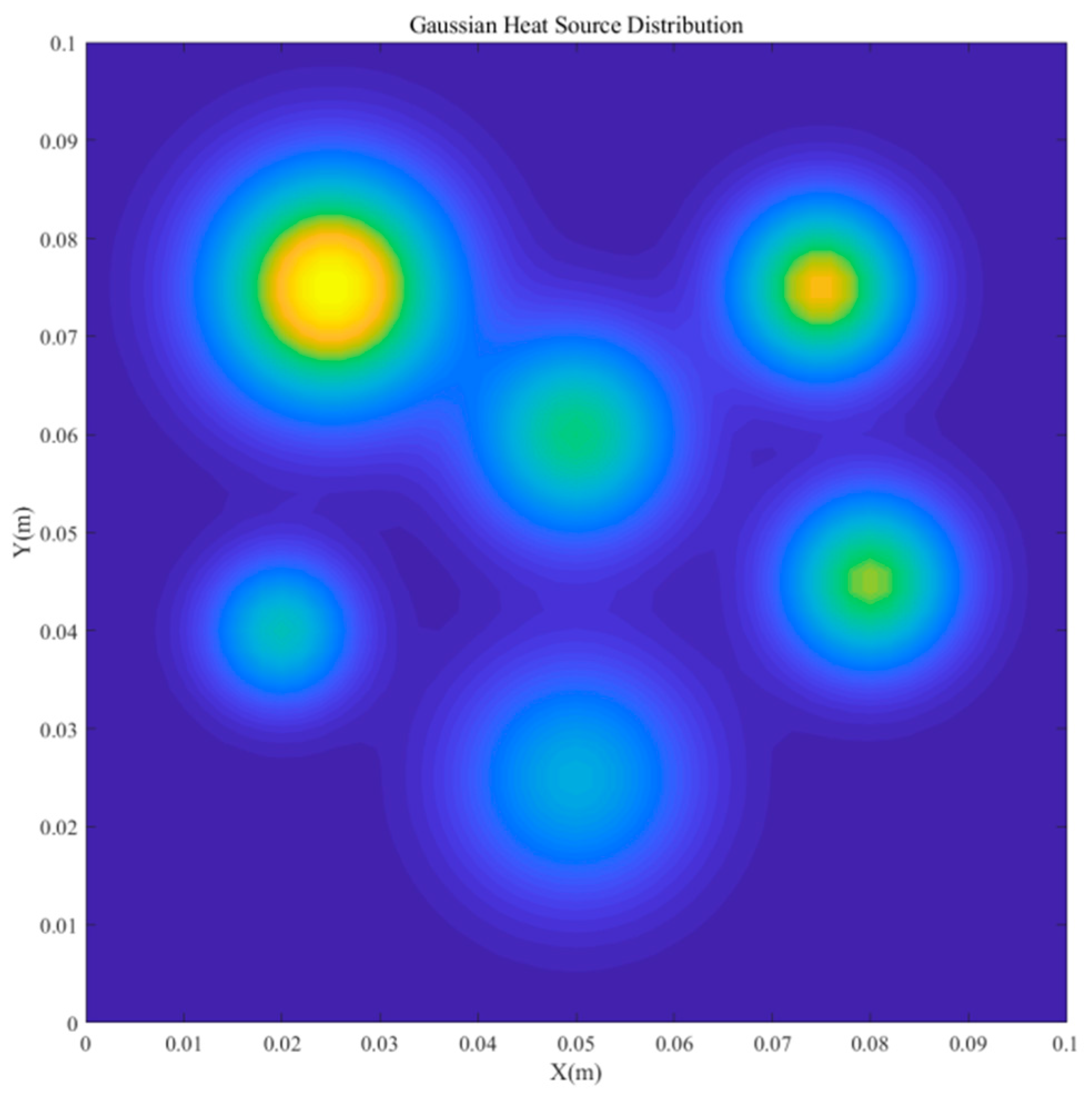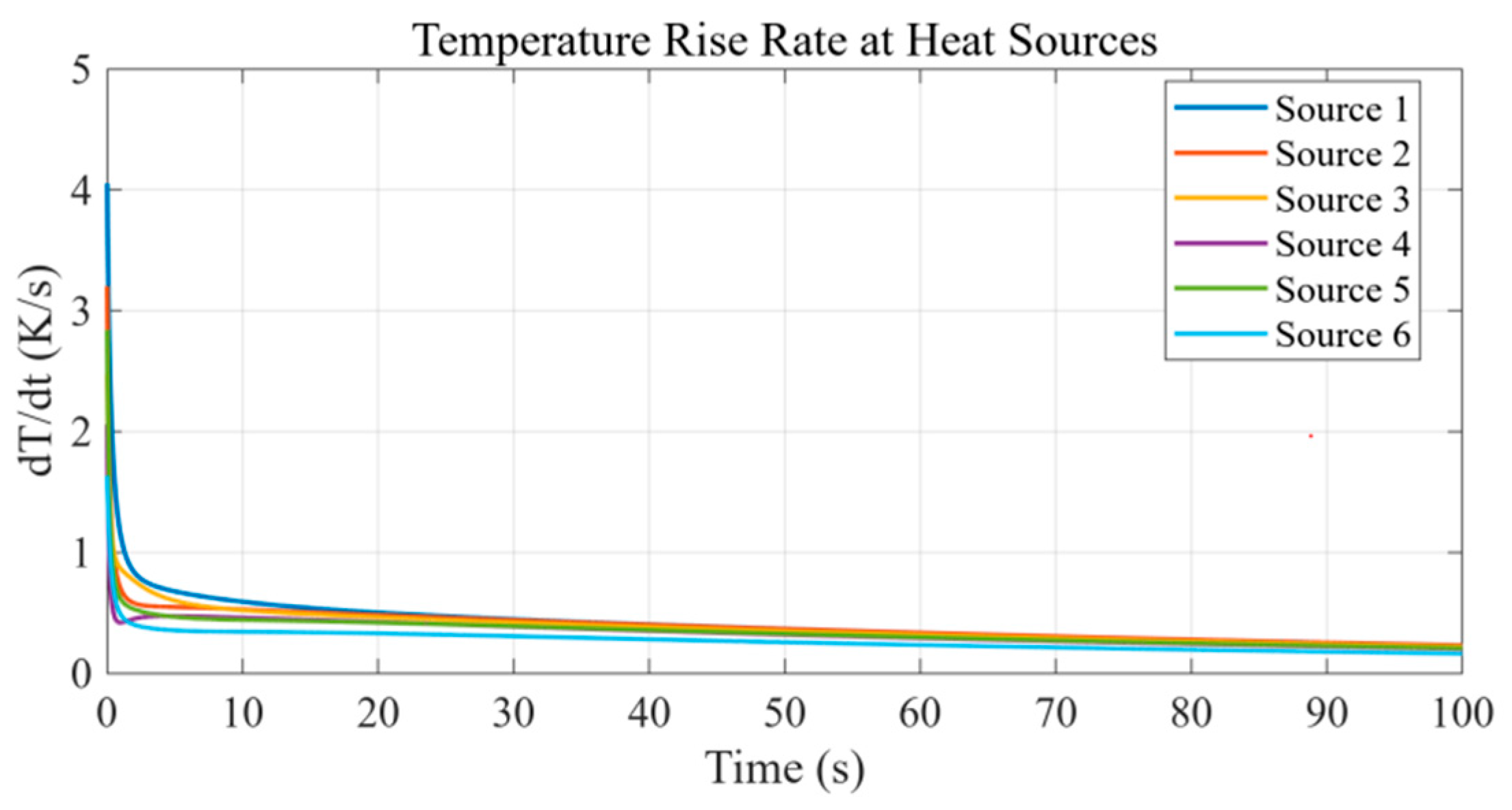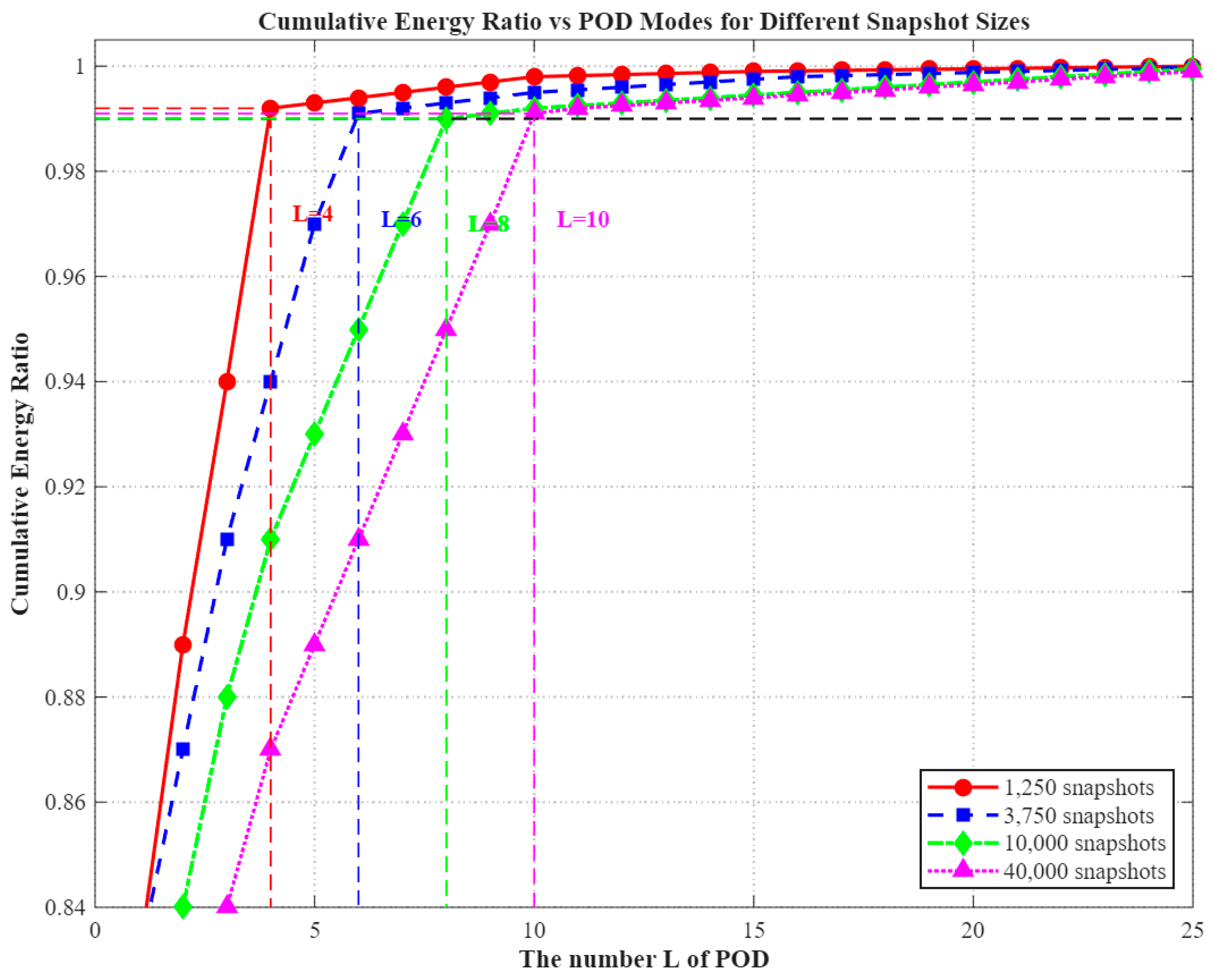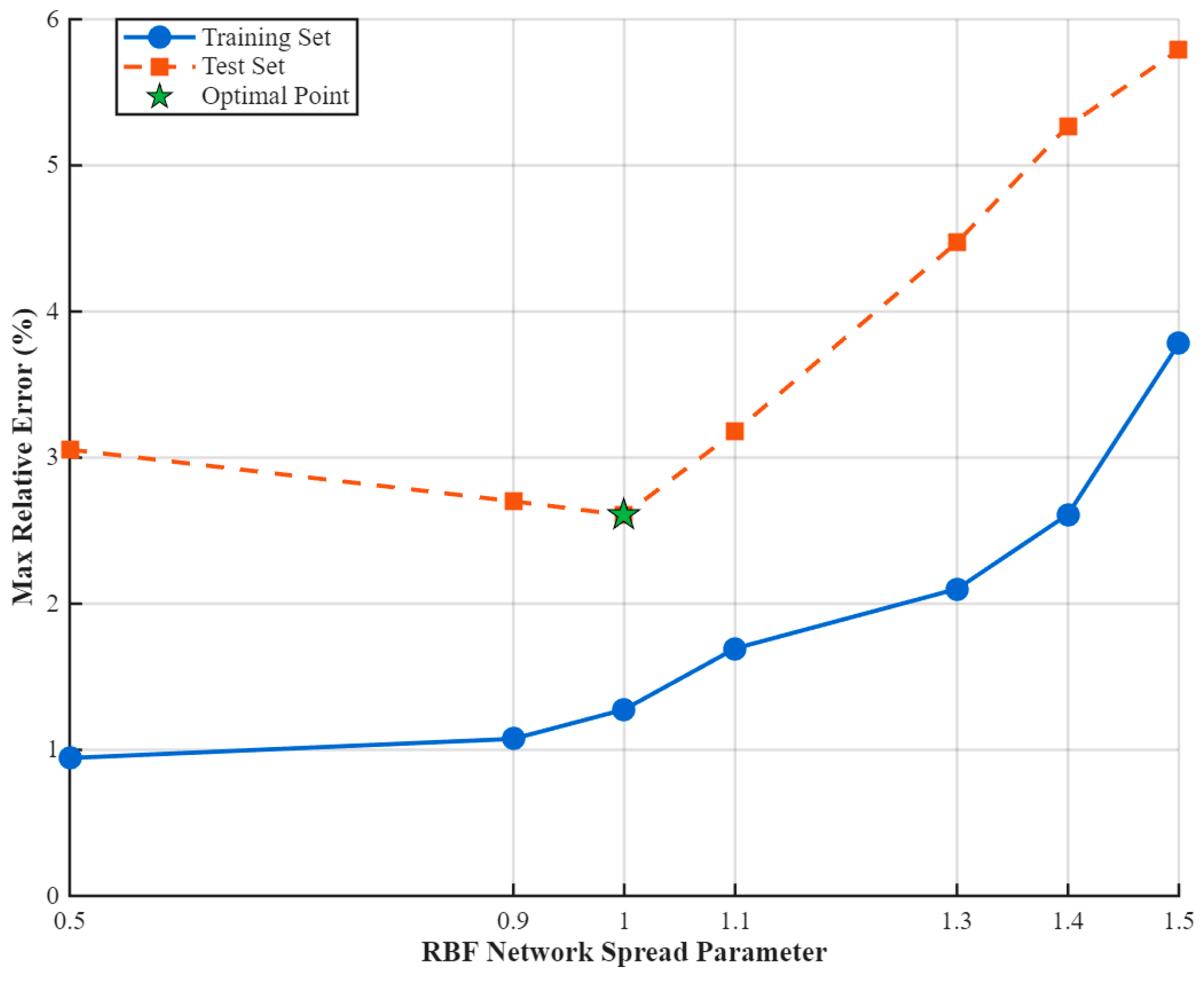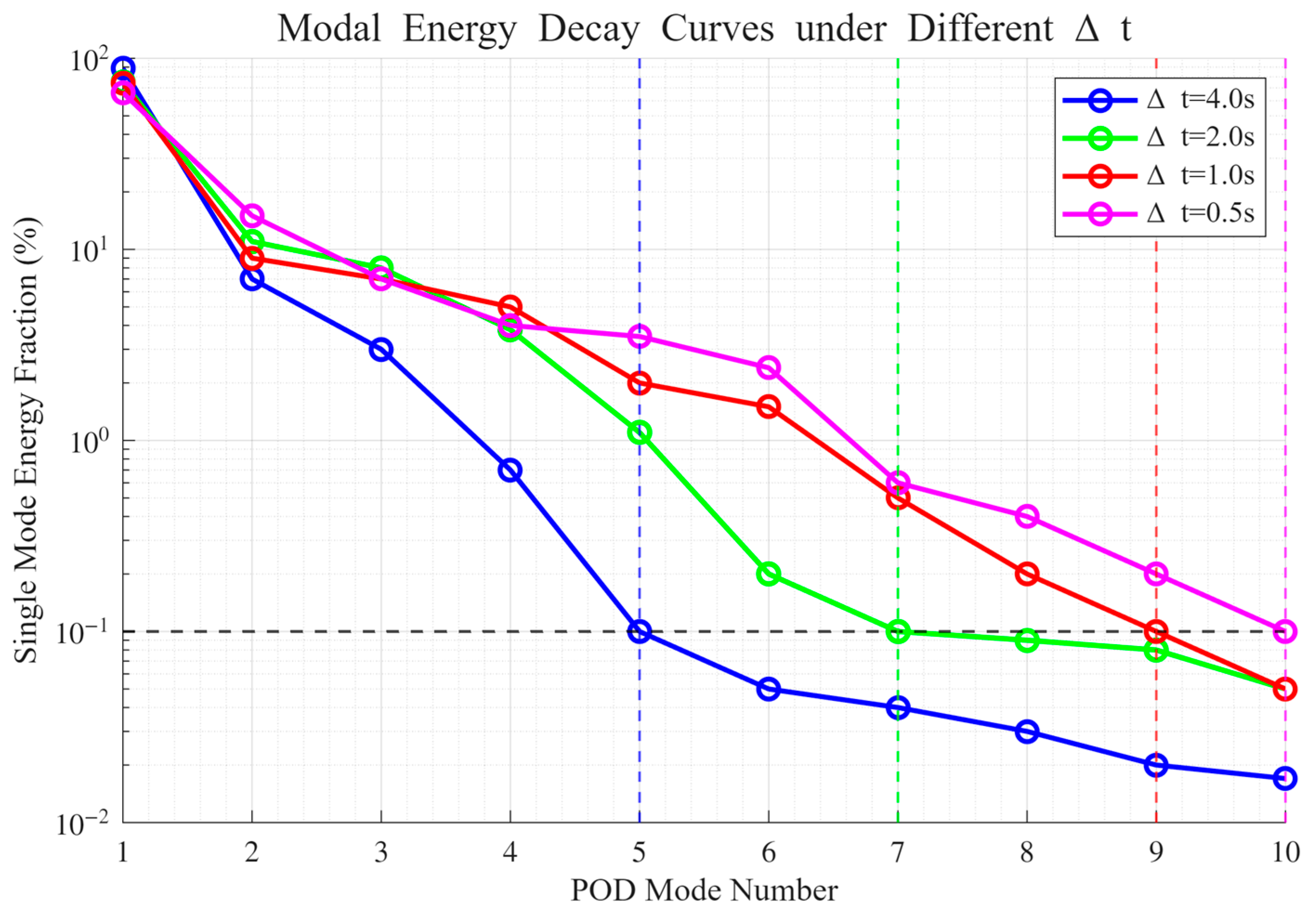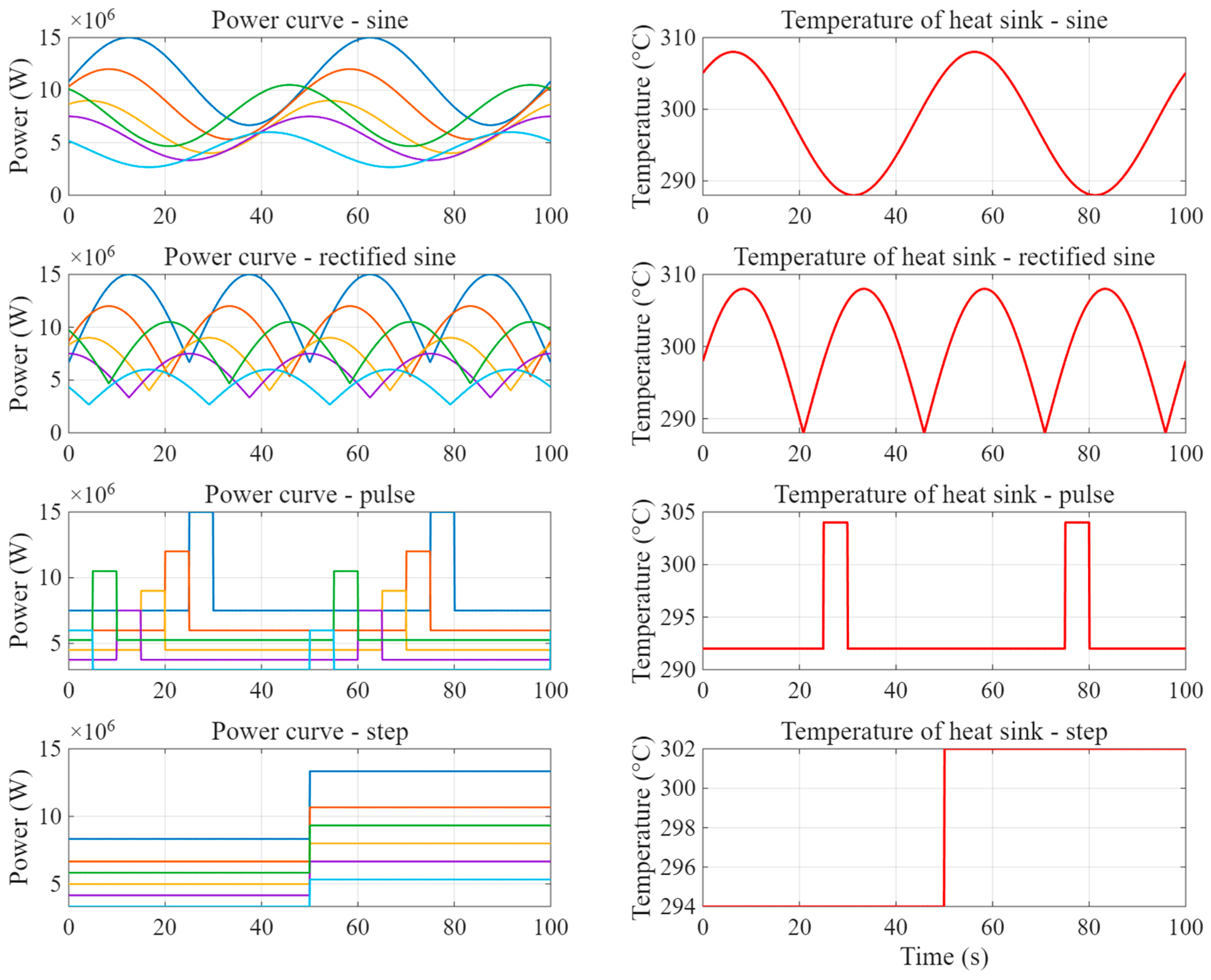1. Introduction
In modern engineering applications, the efficient reconstruction of transient temperature fields holds considerable significance, particularly in the thermal regulation and heat dissipation of advanced electronic systems. Such systems often involve multi-heat-source configurations, localized high heat flux densities, and complex packaging geometries, leading to pronounced nonlinearities and multi-scale temporal–spatial behaviors. Similar challenges also arise in controlling thermal effects during laser-based manufacturing and in the design of thermal protection systems for aerospace vehicles [
1,
2]. Achieving accurate transient field prediction under strict time constraints has consequently emerged as a critical challenge across engineering thermal control and computational modeling.
Historically, conventional full-order numerical techniques—most notably the Finite Element Method (FEM) and Computational Fluid Dynamics (CFD)—have played indispensable roles in the study of transient heat conduction problems. Nonetheless, when addressing high-dimensional domains or spatially distributed heat sources typical of complex electronic assemblies, FEM/CFD simulations become computationally prohibitive, often falling short of the real-time prediction and rapid prototyping requirements [
3].
To address this bottleneck, reduced-order modeling (ROM) techniques have gained traction, among which the proper orthogonal decomposition (POD) method, underpinned by singular-value decomposition, has been extensively applied to the reconstruction of flow and temperature fields due to its efficiency in modal extraction and dimensionality reduction [
4,
5,
6,
7,
8,
9,
10,
11,
12,
13]. POD effectively retains dominant energy modes, achieving substantial compression; however, as an intrinsically linear technique, its predictive capacity is inevitably diminished in scenarios involving strongly nonlinear transient dynamics or complex excitations [
14].
In order to overcome the limitations of traditional ROM in nonlinear modeling, the POD–neural network (POD-NN) framework has emerged. The core concept is to exploit the nonlinear regression capability of neural networks to capture complex temporal or parametric dependencies of POD mode coefficients [
15]. Specifically, dominant modes are first extracted via POD, and subsequently, a neural network is trained to learn the nonlinear mapping between input parameters (or time) and the corresponding modal amplitudes, thereby markedly enhancing the expressive power of the reduced-order model [
16]. Empirical evidence has shown that POD–NN achieves superior accuracy–efficiency trade-offs across applications in both fluid mechanics and heat transfer [
17,
18,
19,
20,
21].
Nevertheless, several persistent gaps remain in the current research on POD–NN frameworks, particularly with respect to data strategy design and generalization assessment:
- (a)
Parameter-sampling strategy deficiencies
Sampling protocols for the training database often suffer from a trade-off between parameter–space coverage and computational cost. Uniform or random sampling remains prevalent, leading to insufficient coverage in high-dimensional parameter spaces. For instance, Ref. [
5] used fixed grid points and constant time steps in flow-field simulations, with the offline training computational cost being 7–10 times that of online inference. Similarly, Ref. [
22] noted that “the number of training parameters is limited” in their DMD-parameterized model but offered no quantitative optimization scheme.
- (b)
Suboptimal temporal-sampling strategies
Time series data are frequently handled via fixed-step sampling or empirically chosen sub-sampling, which fails to capture rapid transients effectively. In Ref. [
23], a constant,
, was adopted for magnetic–circuit coupling simulations, leading to loss of high-frequency dynamics. Ref. [
24] introduced an adaptive POD–Petrov–Galerkin projection in thermal radiation modeling; however, the time step adaptation still relied on empirical values without specifying error thresholds and lacked an error- or energy-metric-driven sampling mechanism accompanied by controlled comparative experiments.
- (c)
Limited generalization evaluation
Generalization assessments are primarily restricted to “interpolative” perturbations in amplitude or frequency (e.g.,
amplitude variation or small frequency shifts). For example, Ref. [
25] compared the generalization capacities of different neural network architectures in solid mechanics modeling, yet only under static loading, with no consideration of dynamic excitation. Ref. [
26]’s S
2GM model demonstrated robustness against sinusoidal disturbances in spatiotemporal reconstruction (vorticity field nRMSE < 0.1; see Figure 3e) but omitted scenarios involving step or pulse inputs with intense short-duration excitations. Ref. [
27] tested the extrapolation capability of an RBF-based model from single-pulse to multi-pulse excitations in electromagnetics but did not evaluate alternative excitation patterns.
- (d)
Inconclusive surrogate model selection
Compared with deep multilayer perceptrons (MLPs) or recurrent architectures, Radial Basis Function Neural Networks (RBF-NN) offer advantages under small-sample regimes, including smooth-mapping capability and stable training behavior. These properties make RBF-NN an appealing choice as a lightweight nonlinear regressor for high-dimensional POD mode coefficients. For instance, Ref. [
28] demonstrated that in PDE-solving contexts, RBF-NN requires fewer than 100 snapshots for training and exhibits greater stability than MLP (see
Section 3 of the original work). In contrast, mainstream approaches such as the POD–DL-ROMs in Ref. [
4] leverage deep autoencoders, where extrapolative training demands may exceed
samples. Notably, existing POD–RBF studies typically omit explicit inclusion of time as an input feature; for example, Ref. [
29], covering materials optimization, similarly excluded time from the RBF-NN input vector.
To address the limitations observed in previous studies—namely, inefficient optimization of sampling strategies, inadequate balancing of temporal resolution, and insufficient validation of generalization across distinct operating conditions—this work focuses on reconstructing transient temperature fields generated by a two-dimensional Gaussian heat source representative of localized thermal loading in complex electronic assemblies. We propose a nonlinear reduced-order modeling framework that couples proper orthogonal decomposition (POD) with neural networks to enhance predictive capabilities under strongly nonlinear transients and intricate time-dependent boundary constraints.
First, a high-fidelity reconstruction method is developed by integrating POD with a radial basis function neural network (RBF-NN), as outlined in
Figure 1. Second, the generation of the training database is systematically optimized by jointly tuning the temporal sampling interval and the Latin hypercube sampling (LHS) set size, with comparative analyses conducted to achieve both computational efficiency and predictive accuracy. Finally, a training dataset built under stationary, constant boundary conditions and a test suite incorporating markedly different excitation profiles—including sinusoidal, rectified sinusoidal, pulsed, and step inputs—are used to quantitatively evaluate the extrapolation performance across temporal regimes and the stability of the model under representative unsteady scenarios.
The outcomes furnish both methodological and validation foundations for deploying efficient, accurate transient thermal field reconstruction in practical engineering environments, particularly in domains where rapid thermal prediction supports reliable operational management.
The remainder of the paper is organized as follows:
Section 2 formulates the transient heat conduction problem under the two-dimensional Gaussian heat source, including the governing equations, the finite-difference numerical scheme, and boundary/source parameter definitions.
Section 3 details the reduced-order modeling framework, covering dimensionality reduction via POD and the construction of the RBF-NN surrogate mapping input conditions to modal coefficients. Subsequent sections address sampling and temporal resolution optimization and present validation under diverse time-varying conditions to thoroughly assess stability and generalization capability.
2. Two-Dimensional Transient Heat Conduction Model and Numerical Implementation
2.1. Physical System Under Investigation
This study uses a two-dimensional transient temperature field driven by multiple Gaussian heat sources as the validation benchmark for three reasons. First, it is representative: multi-source transient heat transfer occurs widely in advanced electronic assemblies and materials processing, and a 2D Gaussian source (
Figure 2) effectively emulates hotspot formation and dissipation with pronounced spatial–temporal gradients. Second, it has strong engineering relevance: steep temperature gradients impact thermal stresses and reliability, and the results inform cooling design, failure prevention in electronics, and aerospace structures; aluminum’s high thermal conductivity enhances applicability. Third, its multiscale, high-frequency dynamics under both steady and unsteady boundaries provide a rigorous testbed for assessing POD–RBF efficiency and robustness.
On this basis, the subsequent section details the two-dimensional transient heat conduction model and its numerical implementation.
2.2. Governing Equations and Heat Source Modeling
Under laser irradiation, the spatiotemporal evolution of the material temperature field is governed by the two-dimensional transient heat conduction equation:
where
denotes the temperature (K),
is the mass density (kg/m
3),
is the specific heat capacity (J/(kg⋅K)),
is the thermal conductivity (W/(m⋅K)), and
is the time-dependent volumetric heat-source term (W/m
3).
Introducing the thermal diffusivity,
—for an isotropic, spatially uniform k—the equation can be recast as
The heat source is modeled as a superposition of multiple two-dimensional Gaussian volumetric sources:
where
is the number of sources;
denotes the center of the m-th source;
(
) specifies its intensity;
(m) controls the spatial spread of the Gaussian; and
encodes the temporal modulation of the input (e.g., step or pulsed signals).
2.3. Computational Domain and Boundary Conditions
2.3.1. Configuration of the Computational Domain
The numerical experiments consider a two-dimensional transient Gaussian heat-source system. The primary objective is to quantify how alternative sampling strategies and temporal step sizes influence surrogate model performance and to predict both steady and transient temperature fields via a POD-based model order reduction coupled with machine learning.
The computational domain, , is a two-dimensional square populated with six Gaussian volumetric heat sources; boundary conditions and source parameters are detailed in subsequent sections. To ensure numerical stability and accuracy, the simulations are implemented in MATLAB R2023a. Spatial discretization employs a uniform Cartesian mesh of 51 × 51 nodes, corresponding to a grid spacing of 0.002 m.
Material properties correspond to aluminum: density, ; specific heat capacity, ; and thermal conductivity, , yielding a thermal diffusivity of . These properties provide a physically consistent backdrop for two-dimensional heat conduction.
To satisfy the Courant–Friedrichs–Lewy (CFL) stability constraint, the maximum admissible time step is computed as = 1.698 × 10−2 s. Consistent with the choice that sampling instants are integer multiples of 0.5 s, the simulations adopt = 1.0 × 10−2 s. The temporal window spans 0–100 s, producing 10,001 time levels and thereby sufficiently resolving the evolution of the temperature field.
2.3.2. Specification of Boundary Conditions
Six Gaussian volumetric heat sources are deployed within the computational domain; their center coordinates, peak volumetric power densities, and spatial standard deviations are summarized in
Table 1. Each source is spatially represented by a two-dimensional Gaussian distribution, while its power output is held constant in time, thereby emulating the sustained thermal loading from continuously operating components commonly encountered in industrial manufacturing.
A heat sink of constant temperature (298 K) and 0.01 m length is positioned at the center of the lower boundary to absorb heat and establish a steady-state conduction process. The sink spans the interval x ∈ [0.045, 0.055] m; all remaining boundaries are thermally insulated (Neumann boundary condition), ensuring zero heat flux across their surfaces. The initial condition is a uniform temperature distribution of 298 K throughout the computational domain.
2.4. Numerical Solution Procedures
- (a)
Finite Difference Method (FDM)
For numerical integration and subsequent snapshot acquisition, a uniform Cartesian grid with spacings of
is adopted together with explicit finite differences. At interior nodes, the two-dimensional Laplacian is discretized using second-order central differences:
Time integration proceeds via the explicit update:
where
and
.
To satisfy numerical stability under the Courant–Friedrichs–Lewy (CFL) constraint, the time step Δ
t is chosen as a critical value with an empirical safety factor,
and, in practice, Δ
t is computed to ensure
.
- (b)
Boundary Condition Implementation
The initial condition is specified as a uniform temperature field: .
Boundary conditions are discretized as follows: A Dirichlet boundary condition is enforced at the central segment of the bottom boundary, defining a constant-temperature heat sink of length . Within the interval , the temperature is fixed: .
All remaining boundaries (i.e., the top, left, right, and non-sink segments of the bottom boundary) are subjected to Neumann conditions (adiabatic), implemented via zero-gradient constraints. This is numerically realized by mirroring/copying the values of adjacent interior nodes to enforce a zero gradient at the boundary.
For subsequent proper orthogonal decomposition (POD) model reduction and surrogate model training, temperature snapshots are archived at predefined intervals during the computation. The time series is recorded to construct the snapshot matrix.
2.5. Case Study: Transient Temperature Field Simulation with Two-Dimensional Gaussian Heat Sources
To facilitate subsequent investigations based on reduced-order and surrogate modeling, we present a canonical transient heat transfer case featuring two-dimensional Gaussian areal heat sources, thereby illustrating the practical application of the preceding theory and numerical methodology.
- (a)
Computational domain and source layout
The computational domain is a 100 × 100 mm
2 planar region populated with six Gaussian-form areal heat sources.
Figure 3 delineates their spatial locations and volumetric power density distribution: white markers indicate source centers, while the colormap encodes the magnitude of the power density, with Source 1 attaining the highest amplitude.
- (b)
Initial and boundary conditions
The initial temperature is uniformly set to 298.0 K. Both the governing equation and boundary treatments follow the transient heat conduction model articulated previously. The outer boundary is subjected to convective (Newtonian) heat exchange, and the simulation time horizon spans t ∈ [0, 100.0] s.
- (c)
Numerical solution and overview of results
Transient temperature fields were computed using finite-difference/finite-element iterative schemes, yielding spatial distributions at multiple time instants.
Figure 4 presents the following:
t = 0 s: The uniform initial temperature field;
t = 10.0 s, 30.0 s, and 100.0 s: The evolution of the temperature distribution, wherein localized hot spots progressively emerge at the source loci and diffuse outward.
In addition, the instantaneous temperature rise rate at each source center was evaluated and extracted. As shown in
Figure 5, when time approaches
t = 100.0 s, the rate at all sources drops below 1.0 K/s and exhibits a clear flattening trend. This reflects that, over this time scale, the transient response has entered a quasi-steady regime; however, the rates remain small but non-zero because the selected time horizon did not fully reach a strict steady state. In practice, the simulation duration is chosen to suit engineering application requirements—here, 100 s was sufficient to capture the dominant heat conduction dynamics, as indicated by the flattening curves. These results constitute the raw dataset for subsequent POD-based model reduction and RBF surrogate construction.
3. Construction of the Surrogate Model
In the two-dimensional transient temperature field with multiple Gaussian heat sources described in
Section 2, classical finite element/finite difference solvers deliver high-fidelity solutions but demand dense spatial meshes and small time steps—especially under multi-source, multi-scenario settings—leading to prohibitive computational costs that are incompatible with real-time prediction or parameter optimization in engineering practice. To address this limitation, we adopt a reduced-order surrogate modeling strategy: salient features of the temperature field are extracted via proper orthogonal decomposition (POD), reducing the dimensionality from M spatial degrees of freedom to L low-order modes (with
L ≪
M). A surrogate model is then trained to map input parameters to the POD-reduced coordinates, enabling rapid and accurate prediction of complex temperature fields.
This dimension-reduction–surrogate framework substantially curtails computational time while preserving the dominant dynamical characteristics of the original model, thereby providing an efficient tool for multi-scenario analyses, real-time control, and optimization-oriented design in engineering applications.
3.1. Proper Orthogonal Decomposition (POD)
To reduce the computational dimensionality and extract the dominant feature content, the proper orthogonal decomposition (POD) method is applied to the temperature field.
Temperature solutions from finite-element simulations under multiple operating conditions are sampled at selected time instants to assemble the snapshot matrix:
Here, M denotes the number of spatial degrees of freedom and equals , where and are the numbers of nodes in the X and Y directions, respectively. N is the total number of snapshots and equals , where is the number of temporal samples per sampling group () and n is the number of sampling groups (e.g., operating scenarios).
The snapshot matrix,
, is factorized via singular value decomposition (SVD):
where
is the left singular matrix, which also serves as the POD basis;
is the right singular matrix; and
is the diagonal matrix of singular values.
Given the prohibitive size of
, constructing the full POD orthonormal basis directly is an intractable problem. Therefore, we adopt the method of snapshots, wherein the POD basis is approximated by a truncated matrix,
, defined by
where
, and
and
denote the eigenvectors and eigenvalues of the correlation matrix,
.
The number of retained modes,
, is determined by a cumulative energy criterion,
with
typically set to 99%.
Under this construction, the finite-element snapshot corresponding to the operating parameters,
, can be approximated as
where
is the l-th POD basis function, and
is the associated modal coefficient.
As indicated above, the finite-element solution is represented as a linear combination of POD modes; since , the reduced-order model markedly curtails the computational burden while retaining the dominant thermal dynamics of the original high-fidelity system.
3.2. Surrogate Model Formulation
Following POD-based dimensionality reduction, a surrogate model is constructed to enable rapid prediction of temperature fields under varying operating conditions. In this framework, boundary conditions, together with time, are treated jointly as input variables that are mapped to the POD modal coordinates.
A radial basis function (RBF) neural network is adopted due to its simplicity, effectiveness, and strong generalization across steady and non-steady inputs, including periodic, pulsed, and step-like excitations. As illustrated in
Figure 6, the RBF surrogate comprises three layers: input, hidden, and output.
In Equation (15), the input layer, f(1), comprises eight neurons that encode the power density,
; the heat-sink temperature,
; the time,
t; and related boundary condition descriptors. The hidden layer, f(2), contains N neurons [
φ1,
φ2,
φ3, …,
φn], where φ denotes the j-th radial basis kernel (typically Gaussian). The output layer, f(3), consists of L neurons,
, where
represents the POD modal coefficients.
This can subsequently be computed via Equation (14). From the input layer, f(1), to the hidden layer, f(2), distinct radial basis kernels map the inputs—power density,
; heat-sink temperature,
; and time,
t—into the hidden representation. From the hidden layer, f(2), to the output layer, f(3), a linear combination of n radial basis functions is employed to approximate the l-th POD coefficient,
.
The output,
, of the l-th neuron in the output layer is given by
where
denotes the RBF weights,
is the j-th RBF interpolation kernel,
is the L2 norm, and
is the center of the j-th kernel. Common choices of φ include linear, cubic, quintic, thin-plate spline, Gaussian, multiquadric, and inverse multiquadric functions. For convenience, let
denote the joint input of operating parameters and time. Imposing the interpolation constraint—namely, setting the RBF surrogate’s prediction equal to the ground-truth value at each training input,
=
, via Equation (17)—a linear system can be created in the unknown coefficients
.
By solving Equation (17), one obtains the weight vector,
, associated with the l-th output. Consequently, for any new input,
, the corresponding POD coefficients are predicted as
.
3.3. Dataset Construction and Sampling Strategy
To systematically evaluate the influence of the number of sampled realizations,
G, and the temporal sampling interval, Δ
t, on surrogate model performance, a Latin hypercube sampling (LHS) method was adopted to ensure space-filling diversity across the physical parameter space. The sampling bounds were extended directly from the baseline thermal source data listed in
Table 1,
Section 2.3.2, thereby maintaining consistency with the initial physical configuration and guaranteeing physically admissible conditions.
The parametric space comprises six volumetric heat source power densities and one heat-sink temperature, forming a seven-dimensional input domain. In compliance with the probability-density-function-based physical validity constraint (
R ≤ 2.5), the range of each heat source power,
qi, was defined by a symmetric scaling factor,
λp = 1.5:
where
qi0 denotes the baseline power density from
Table 1.
Similarly, the heat-sink temperature,
Tsink, was varied within a physically realistic range of ±10 K around the nominal 298 K:
A total of
G distinct operating conditions were generated via LHS under a fixed random seed to ensure reproducibility. The resulting distribution exhibited balanced coverage and minimal inter-parameter correlation, with mean and standard deviation statistics as summarized in
Figure 7.
The temporal resolution for each simulated condition was determined based on the Courant–Friedrichs–Lewy (CFL) stability criterion of the transient solver, expressed as
where
α is the thermal diffusivity, and Δ
x is the spatial grid size. The integration time step satisfying the above constraint was used to ensure numerical stability throughout transient computations.
Subsequently, multiple sampling configurations were constructed by varying
G = {50, 75, 100, 200} and Δ
t = {0.5, 1, 2, 4} s, which together define the total number of snapshots and cumulative database size. The corresponding dataset characteristics are listed in
Table 2, providing the basis for quantitatively assessing the trade-off between computational efficiency and prediction accuracy in POD–RBF-based surrogate modeling.
3.4. Model Training and POD + RBF Neural Network Implementation
During training, we first perform a POD decomposition on the snapshot matrix assembled from multi-condition temperature fields to extract the dominant modal coefficients, thereby achieving dimensionality reduction and alleviating the input–output burden of the model. To mitigate the adverse effects of cross-modal scale disparities on learning, the extracted POD coefficient sets, , are linearly normalized to the interval [0.1, 1] using the mapminmax procedure. The normalized coefficients then serve as the prediction targets for a radial basis function (RBF) neural network.
The RBF network adopted here is a feedforward architecture whose input comprises eight features (six heat source power components, one heat-sink temperature, and one temporal variable) and whose output is the vector of POD modal coefficients. After extensive empirical optimization, the principal hyperparameters are set as follows:
Training error goal: 1 × 10−4;
RBF spread (kernel width): 1.0;
Maximum number of hidden neurons: 500.
Network construction and training are implemented via MATLAB R2025a’s newrb function, which incrementally adds hidden units until the error goal is met or the preset upper bound on hidden neurons is reached. The resulting topology is
where
denotes the finalized number of hidden neurons and
the truncation level of the POD modes.
Coupled with the POD-based reduction, the RBF network enables rapid inference of the full-field temperature distribution with very short runtimes. In subsequent tests, we validate this surrogate to quantify its predictive accuracy and generalization across varying heat-source powers, boundary conditions, and temporal inputs.
3.5. Theoretical Basis for Extrapolation Stability in the POD–RBF Model
Building upon the preceding exposition of the POD dimensionality-reduction framework and the construction of the RBF network, we have delineated the technical pathway “high-dimensional temperature field to low-dimensional modal coefficients to parameter-to-modal mapping”. A natural question follows: when the input parameters (e.g., time-varying heat source boundary conditions) extend beyond the span of the training samples, why does the model still retain stable accuracy? In this section, we derive the theoretical underpinnings of the method’s extrapolation stability from two complementary perspectives—namely, the energy-distribution characteristics of the POD modes and the generalization capacity of the RBF network—thereby laying a mechanistic foundation for subsequent validation under unsteady operating conditions.
3.5.1. Modal Energy Concentration and Structural Stability in POD
As established in
Section 3.1, the temperature field snapshot matrix,
, admits the singular value decomposition (SVD) given in Equation (22).
Here,
collects the POD basis functions,
is the diagonal matrix of singular values ordered
, and
quantifies the energy carried by the l-th mode
. Under a cumulative energy criterion (e.g., retaining 99% of the total energy), the temperature field,
, admits the approximation in Equation (23),
with
the vector of modal coefficients.
The crux is that the POD basis, , is determined collectively by all training snapshots and thus encodes the dominant spatial signatures of the temperature field—such as steep gradients in the vicinity of the heat sink and localized hot spots around heat source centers. In contrast, time-varying boundary excitations (e.g., heat source power modulation, ) act primarily by modulating the magnitudes and phases of the coefficients, , without compromising the stability of the spatial basis. Consequently, even when test inputs lie outside the range seen during training (for instance, a previously unseen sinusoidal power modulation of a heat source), the principal spatial structure remains well represented by . The resulting error predominantly originates from the truncated modes that collectively account for less than 1% of the energy and from any residual inaccuracies in predicting the modal coefficients, .
3.5.2. Smooth Generalization Capability of RBF Networks in the Parameter–Time Space
Following the RBF construction in
Section 3.3, the mapping from the input parameters,
—where
denotes heat source descriptors and
t is time—to the l-th POD modal coefficient,
, is given by Equation (24):
where
are the radial centers;
is the shape (spread) parameter; and the weights,
, are determined via least-squares fitting. For a continuous target function,
, defined on a compact set,
(with d equal to the number of parameter dimensions plus one for time), the RBF approximation satisfies the uniform error bound,
, where
is a constant,
reflects the smoothness of
, and
denotes the empirical training error, which diminishes as the sample size increases. Because the temperature field evolution is governed by a parabolic heat conduction equation, the map,
to
, possesses inherent continuity and smoothness: small perturbations in heat source power, for example, do not induce abrupt changes in the thermal response. Leveraging globally weighted radial basis functions, the RBF network, therefore, performs smooth interpolation over regions of the parameter space not explicitly covered during training. This property ensures that, under moderate extrapolation within physically reasonable ranges, the prediction error for the modal coefficients remains controlled, thereby averting the divergence commonly observed in conventional linear extrapolation schemes.
3.5.3. Integrated Extrapolation Error Control in the POD–RBF Framework
Synthesizing the above analysis, the temperature field prediction error admits the decomposition in Equation (25):
where
is the POD truncation error (typically negligible), and
is the RBF-induced coefficient error. The energy concentration of the POD spectrum guarantees a bounded operator norm,
, while the smooth generalization of the RBF mapping constrains the growth of
. In concert, these properties stabilize the overall extrapolation error at a low level. This theoretical result provides mathematical support for high-accuracy prediction under nonstationary boundary conditions—such as sinusoidal, pulse, and step inputs—with
Section 4.3 offering empirical validation of this conclusion.
3.6. Performance Evaluation Metrics
The surrogate model’s performance was assessed from two complementary perspectives: prediction accuracy and computational efficiency.
- (a)
Accuracy Metrics:
The global mean relative error (MRE) and maximum relative error (MaxRE) were employed to quantify predictive fidelity. MRE characterizes the overall accuracy in reconstructing the transient temperature field, encapsulating spatially averaged agreement between predicted and reference solutions. MaxRE reflects the worst-case local deviation, thereby providing a stringent measure of accuracy in regions exhibiting steep gradients or complex thermal interactions.
The mean relative error (MRE) and the maximum relative error (MaxRE) are defined as follows:
where
denotes the total number of spatial grid points.
represents the temperature predicted by the surrogate model, while
denotes the reference solution obtained via the finite-difference method.
where
and
denote the predicted and reference (ground-truth) temperature values of the
sample, respectively.
- (b)
Efficiency Metrics:
Computational efficiency was evaluated using the per-sample inference time of the surrogate model and the database storage footprint. The inference time indicates the model’s suitability for real-time or near-real-time applications, while the storage metric reflects the scalability and deployability of the framework under varying resolution and database sizes.
Together, these metrics offer a balanced appraisal of the model’s ability to deliver high-fidelity transient field predictions while satisfying practical constraints on computational resources.
5. Conclusions and Perspective
This work addresses efficient prediction of transient, non-stationary temperature fields relevant to advanced electronic systems by proposing and validating a hybrid surrogate modeling framework that integrates proper orthogonal decomposition (POD) model reduction with radial basis function (RBF) interpolation. The method is developed through multi-scale database construction, spectral energy analysis, unified modal truncation, and network parameter optimization and is evaluated under stringent accuracy and efficiency targets.
- (a)
Method and Theoretical Basis
A unified POD–RBF architecture is formulated, exploiting the parabolic nature of heat transport and the smooth dependence of POD coefficients on governing parameters. A bound on global extrapolation error is established from controllable POD truncation and RBF prediction terms, enabling high-fidelity modeling of complex boundary excitations, including sinusoidal, pulsed, and step inputs common in electronics cooling scenarios.
A spatial modal truncation order, L, is determined via a cumulative energy criterion to guarantee ≥99% completeness, preventing loss of local hotspot features in reduced datasets.
Temporal sampling optimization balances transient feature fidelity and database size by joint consideration of energy retention and accuracy degradation rates, producing a reusable procedure for efficient surrogate construction.
- (b)
Key Results
Accuracy: Under different non-stationary inputs—sinusoidal, rectified sine, pulsed, and step—global mean relative error (MRE) stayed between ~0.3% and ~2.3%; MaxRE remained <3%. Worst-case deviations (<5 K) occurred in multi-source overlap zones, attributable to truncating high-order modes (~0.9% energy).
Efficiency: L = 10 satisfied energy completeness and reduced inference time to ~8.7 ms per sample, meeting sub-10 ms control thresholds. Accuracy and retention metrics were stable across snapshot scales.
Spectral behavior: Energy completeness remained above 99% across snapshot counts from 1250 to 40,000, supporting the cross-resolution robustness of the truncation strategy.
- (c)
Temporal Sampling Strategy
Using the highest-resolution dataset as a reference, Δt = 1.0 s was selected as optimal: it retained rapid transient behavior (e.g., hotspot growth during activation) while halving storage compared to Δt = 0.5 s. Coarsening to Δt = 4.0 s caused substantial early-stage information loss. The workflow generalizes to other transient multiphysics surrogates.
- (d)
Limitations and Future Work
Errors are found to cluster in strongly coupled multi-source regions, indicating that finite order modal truncation and the use of global RBF weights may underperform under highly nonlinear or steep gradient conditions. Although demonstrated here on a simplified 2D transient conduction case without convection or radiation, the POD–RBF framework is physics- and geometry-agnostic. For more complex scenarios—such as fully 3D multilayer structures, heterogeneous materials, or cases involving coupled thermal radiation and convection—these additional physical effects are incorporated during the offline high-fidelity snapshot generation stage, while the POD decomposition and RBF regression steps remain unchanged. In high-degree-of-freedom problems, dimensionality reduction benefits are expected to be further amplified.
- (e)
Future planned extensions
Adaptive spatiotemporal sampling and multi-resolution POD strategies for capturing rapid transients more efficiently;
Incorporation of physics-informed machine learning approaches (e.g., PDE-constrained RBF, physics-informed neural networks, and Gaussian processes) to reduce extrapolation uncertainty;
Integrated uncertainty quantification and robustness testing;
Expanded application to coupled convection–radiation problems, variable material properties, and experimentally validated fusion scenarios;
Lightweight inference architectures and online learning capabilities for real-time or embedded thermal management integration.
The proposed POD–RBF surrogate framework combines theoretical completeness with engineering practicality for modeling transient thermal transport in electronic devices. By employing unified modal truncation and optimized temporal sampling, the approach achieves sub-3% worst-case error and millisecond-scale inference, making it suitable for on-board or embedded thermal management applications. Its robust, cross-resolution performance enables accurate prediction of hotspot dynamics, temperature gradients, and cooling efficiency in representative scenarios, such as multi-chip modules, densely packaged circuits, and aerospace avionics. This methodology provides a transferable route for intelligent thermal design, accelerated simulation, and integration with control systems in advanced electronic thermal management contexts, while maintaining scalability to more complex, multiphysics, and three-dimensional configurations.

